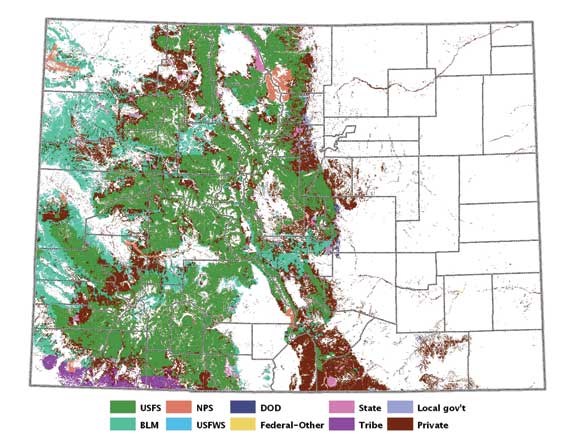Colorado Land Ownership
Decisions regarding the management, use and condition of Colorado’s forests are complicated by a mosaic of public and private ownerships ranging in size from a single acre to several million acres.
Each entity brings with it a unique set of philosophies, directives and regulations that further influence the decisions made about their particular part of the forest, as well as the options available to surrounding landowners.
Approximately 65% of Colorado’s forests are in federal ownership; the primary land manager is the U.S. Forest Service with 47 percent or 11.3 million acres. Nearly three-quarters of the state’s high-elevation species such as spruce-fir, lodgepole pine and aspen are located on USFS lands. The Bureau of Land Management oversees an additional 17 percent or 4.2 million acres, primarily in the state’s lower elevation piñon-juniper and oak shrubland forests. The National Park Service has responsibility for 380,925 acres or 2 percent of Colorado’s forests; the majority of these lands are within the borders of Rocky Mountain National Park.
(USFS=U.S. Forest Service, BLM=Bureau of Land Management, NPS=National Park Service, USFWS=U.S. Fish and Wildlife Service, DOD=Department of Defense)
Despite this significant federal presence, private landowners also play an important role in the stewardship of Colorado’s forest resources. Approximately 186,000 private landowners control 30 percent or 7.1 million acres of the state’s forested landscapes. Although the majority of these lands are in lower elevations, private landowners are represented in all of Colorado’s forest types, including a notable portion of aspen and mixed-conifer forests.
The remainder of Colorado’s forests is held by a combination of tribal governments, municipalities, state agencies and other non-federal entities. The Colorado State Land Board, for example, owns approximately 370,000 acres of forest land throughout the state; the largest parcel is the Colorado State Forest near Walden. Two resident tribes, the Ute Mountain Utes and Southern Utes, make their home in southwest Colorado where they own a total of 402,303 acres of forestland. The vast majority of these acres are in ponderosa pine and piñon-juniper forests. These tribes also retain specific hunting rights and other aboriginal rights on national forests throughout their traditional territory, which includes portions of Utah, New Mexico and Colorado. More than a dozen other tribes located outside Colorado also maintain tribal interests and inherent aboriginal rights in Colorado’s national forests (USFS 2008)1.
Historically, human use of the forest has been constant, ranging from subsistence gathering to harvesting for mining and railroad industries, and management for wildlife habitat, drinking water and recreation. Growing populations, urban development and climate change pose new and demanding challenges for today’s forest managers.
Information about Colorado’s forest types has been reproduced from the Colorado Statewide Forest Resource Assessment and the 2001 Report on the Condition of Colorado’s Forest (1.25 MB PDF).
Text Citation
1United States Department of Agriculture, Forest Service (USFS). 2008. Rulemaking for Colorado roadless areas: draft environmental impact statement. Denver, CO: U.S. Department of Agriculture, Forest Service.


